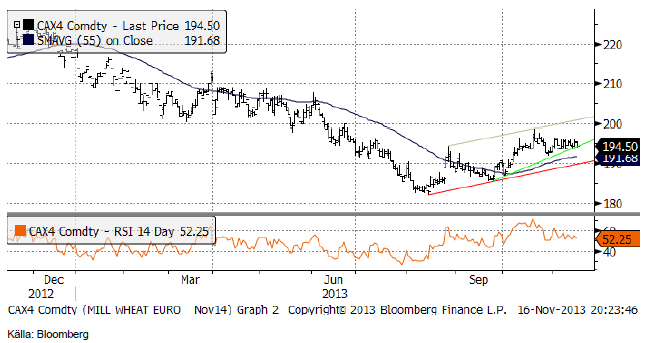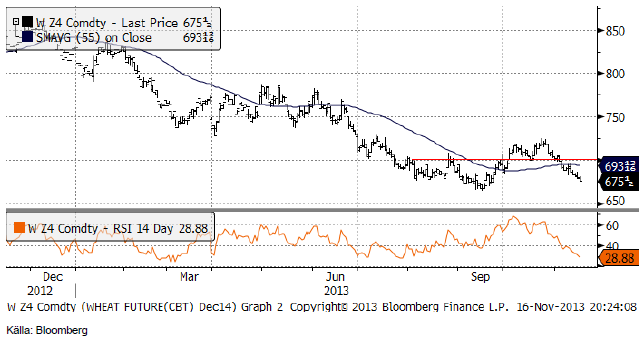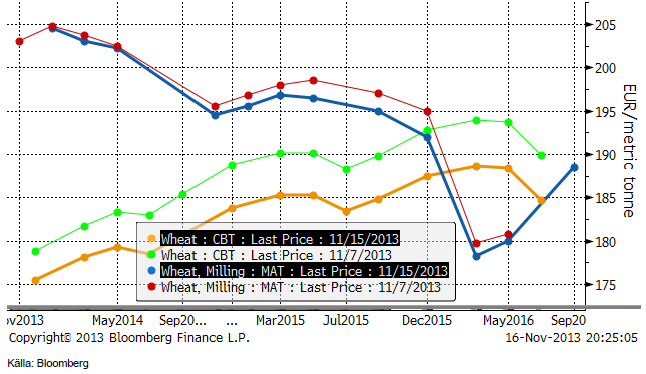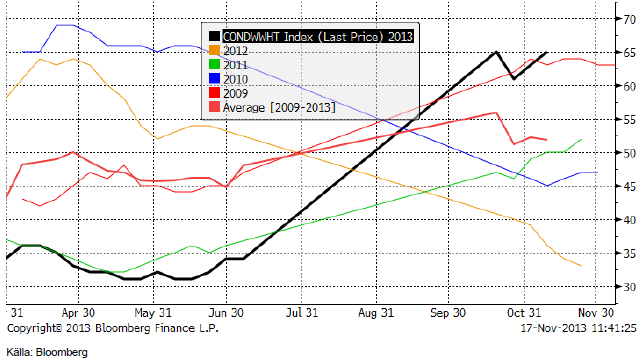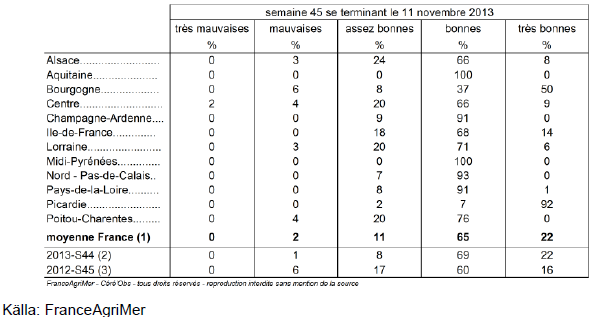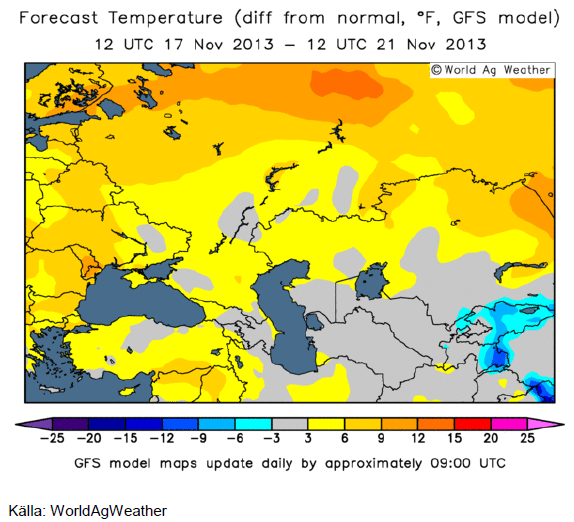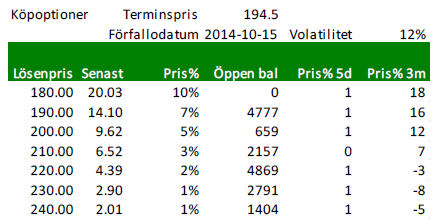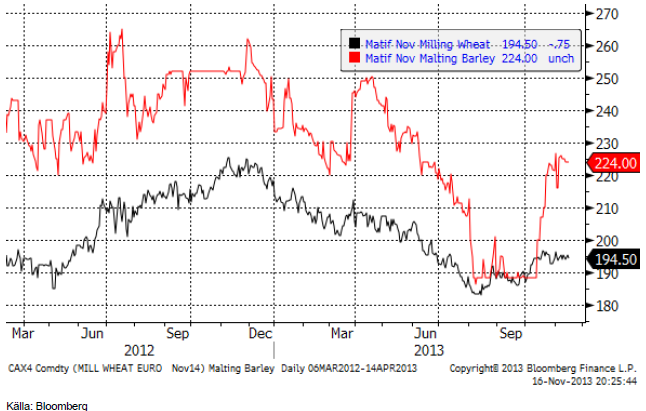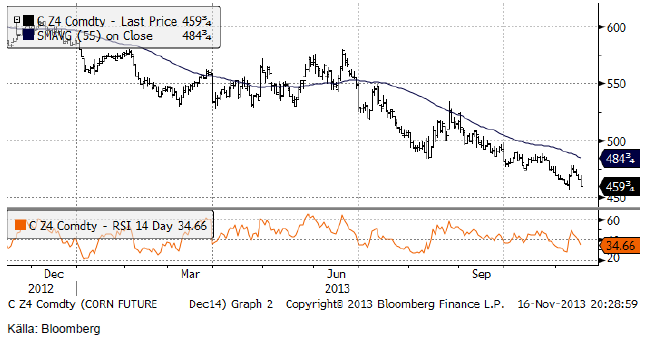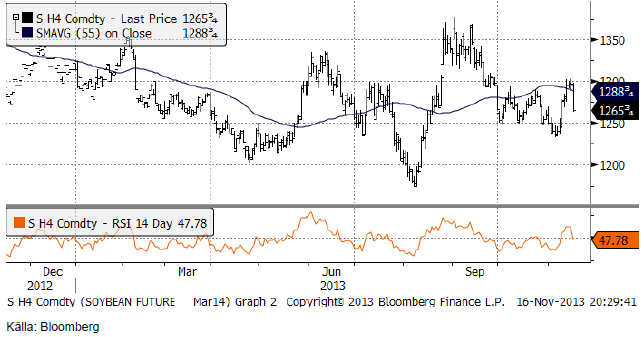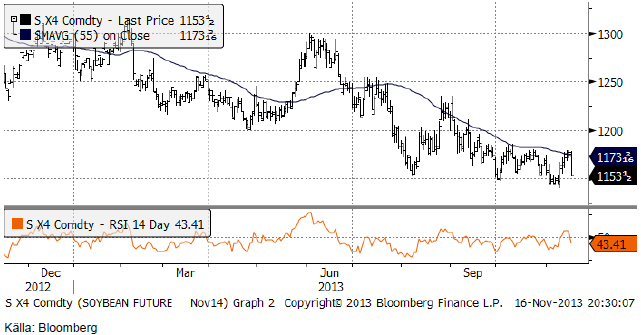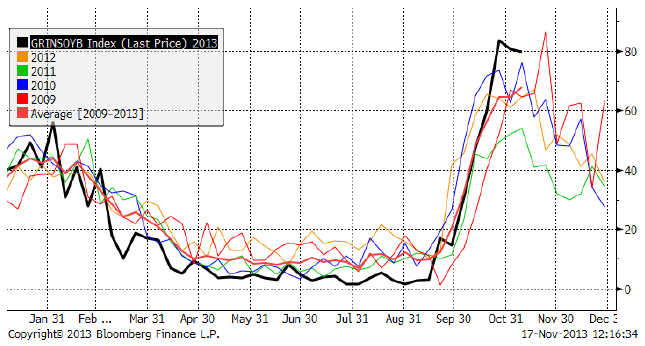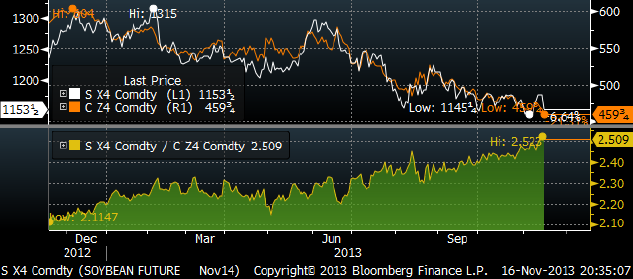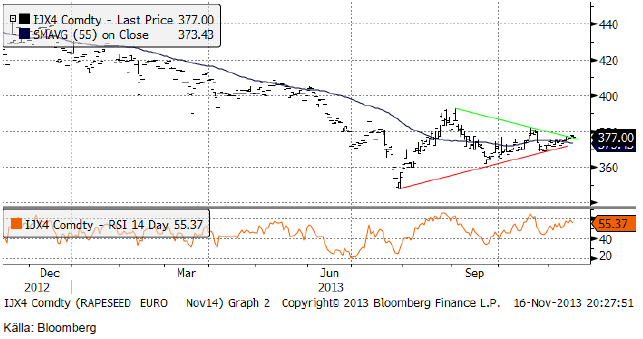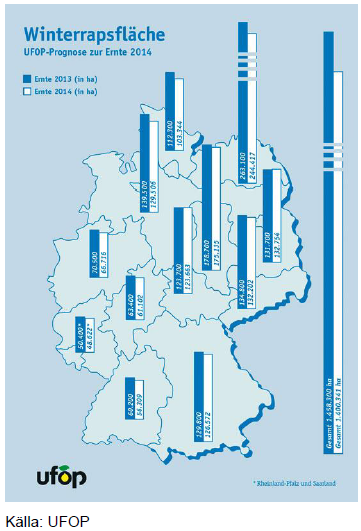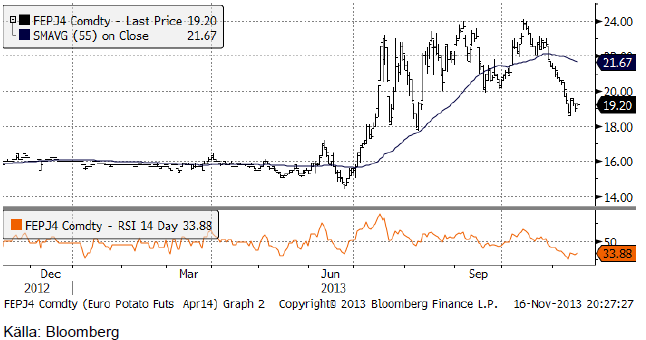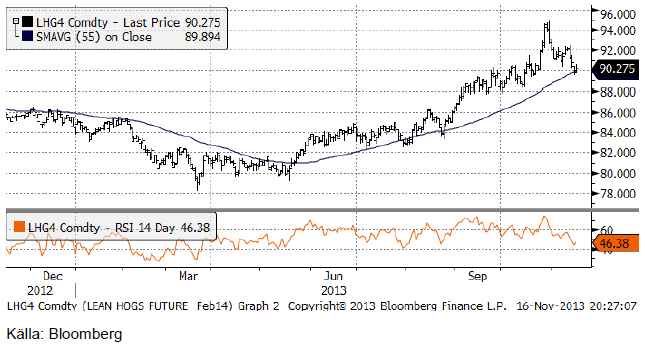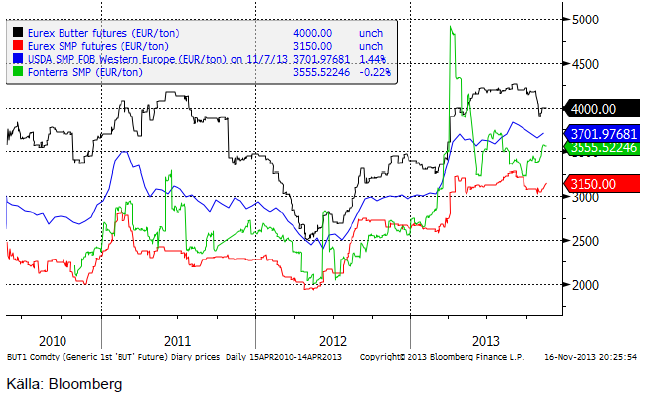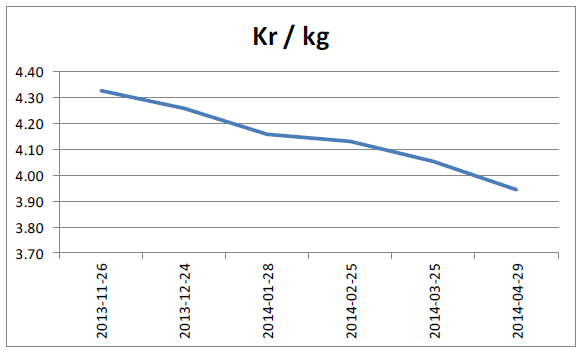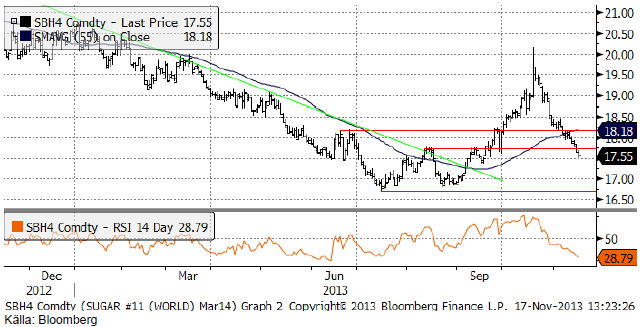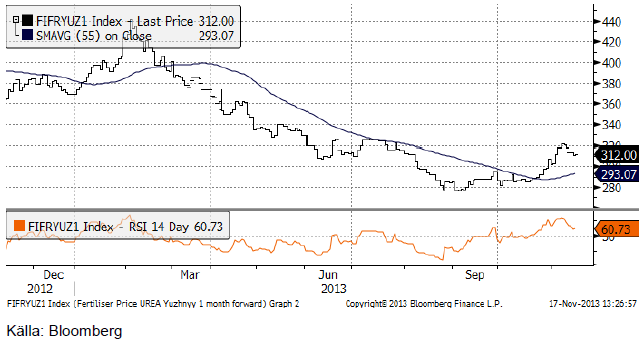Analys
SEB Jordbruksprodukter, 18 november 2013


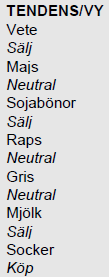 Det hände ganska lite på marknaden i veckan som gick med endast mindre prisrörelser. Informa, Strategie Grains, NOPA och France AgriMer med flera, publicerade rapporter, som marknaden mer eller mindre ignorerade.
Det hände ganska lite på marknaden i veckan som gick med endast mindre prisrörelser. Informa, Strategie Grains, NOPA och France AgriMer med flera, publicerade rapporter, som marknaden mer eller mindre ignorerade.
Tendensen på marknaden var generellt sett negativ, med prisfall på det mesta – utom Mjölk. I svenska kronor steg priset basis Eurex terminer på såväl smör som skummjölkspulver på ett sätt som motsvarar +20 öre per kilo mjölkråvara i Sverige. Den svaga kronan / starka euron bidrog även till att förstärka den allmänna prisuppgången på Eurex.
Vete
November 2014 – kontraktet på Matif har inte lyckats ta sig över 195 euro. Det ser ut som om det finns en ansamling av säljordrar på den nivån. Marknaden stängde på 194.50 euro per ton i fredags, vilket nu är precis på ett tekniskt stöd. Skulle nivån brytas, vilket sker på måndag om marknaden inte stiger, blir det ”fritt” ner till 190 euro per ton. Vi tror att det fallet kommer.
Decemberkontraktet 2014 på CBOT fortsatte falla i pris i veckan som gick, vilket får skillnaden mellan Matif och Chicago att som ett gummiband dras ut ännu mer.
Nedan ser vi terminskurvorna för Chicagovete och Matif. Förändringarna i terminskurvan för Matifvete utgörs av oförändrat pris för de kortare kontrakten, men ett par euro lägre pris för skörd 2014. Terminskurvan i Chicago flyttades i veckan ner med motsvarande 5 euro per ton oavsett löptid; lika mycket för december 2013 som för Juli 2016. Till viss del beror detta på att euron steg med 1% mot dollarn.
Måndagens Crop Progress från visar att sådden av amerikanskt höstvete nu börjar närma sig sitt slut då 95% var avklarad per den 10 november, vilket är strax över förra årets 94% och även högre än det femåriga genomsnittet på 93%.
Uppkomsten av höstvete ligger nu på 84% – vilket är högre än förra årets 78% och det femåriga genomsnittet på 80%.
Andelen grödor klassade som ”good/excellent” fortsätter också att öka och justeras upp från 63% till 65%, vilket är betydligt högre än förra årets 36% vid den här tiden.
Sådden av höstvete i Frankrike är nu avklarad till 85& (per den 11 november), upp från 81% veckan innan. Andelen grödor klassade som ”good/excellent” uppgår till 87%, en nedjustering med 2%.
Egypten har återigen varit i marknaden för köp av vete med leverans i början av december. GASC köpte 180 000 ton franskt vete och 60 000 ton rumänskt vete. Frågan är hur mycket mer vete Rumänien kan exportera med tanke på att de också sålde 20 000 ton till Libanon. Det amerikanska vete som offererades var 10 usd / ton billigare (FOB) än det franska vetet men har ändå svårt att mäta sig pga högre transportkostnaderna över Atlanten.
Kinesiska CNGOIC justerar upp sin prognos för landets import av vete med 500 000 ton till 8 mt, vilket dock är lägre än USDA:s estimat på 8.5 mt. Importen från USA förväntas uppgå till 4.3 mt.
Ryssland håller fast vid sin prognos med en veteproduktion på 50 mt 2014/15, trots lägre sådd areal, då lantbrukare i landet förväntas fortsätta sådden av höstgrödor under november månad till följd av högre temperaturer än normalt. Så här långt uppgår sådd areal till ca 14.4 miljoner hektar (ungefär 88% av den förväntade arealen men fortfarande 8% lägre än förra året). Det varma vädret förväntas fortsätta framöver och i bl.a Moskva uppmättes den varmaste november-temperaturen på 130 år.
Enligt BAGE är nu veteskörden i Argentina påbörjad och avklarad till 6.9%, upp från 3.6% veckan innan och att jämföra med 14.5% vid samma tid förra året. Produktionen beräknas uppgå till 10.25 mt vilket är oförändrat från tidigare estimat.
Basis Matifs behåller vi vår säljrekommendation.
Optioner på vete
Nedan ser vi priserna på köpoptioner på Matif på November-2014 (Matif vete). Notera att volatiliteten har sjunkit ytterligare från 13 till 12% på årsbasis. Det är innebär att optioner på vete är billigare än på länge.
Nedanstående är priser på säljoptioner.
Maltkorn
November 2014 – kontraktet på Matif behöll sin återvunna premie på 30 euro per ton till Matifvetet i veckan som gick.
Majs
Majspriset föll tillbaka i veckan efter den omedelbara uppgången direkt efter WASDE-rapporten, helt i linje med vad jag skrev förra veckan.
Crop Progress rapporten från USDA fortsätter att visa på en snabb framfart för skörden av majs i USA, med en ökning från 73% per den 3 november till 84% en vecka senare, vilket gör att skördetakten ligger strax över det femåriga genomsnittet på 79%. Tar man en närmare titt på ”I-staterna” så är skörden avklarad till 93% respektive 85% i Illinois och Indiana. Ytterligare en aktiv vecka för lantbrukare i Iowa som nu har skördat 88%, en siffra som nu ligger över genomsnittet på 80%.
Amerikanska EPA bekräftade att man kommer att sänka inblandningskravet avseende biobränslen. Däremot låg den aktuella produktionen av etanol på den högsta nivån sedan 17 månader.
Marknaden valde att strunta i att Informa sänkte estimat för majsarealen 2014 till 91.5 mA från det tidigare estimatet 91.7 mA. Enligt USDA var majsarealen i USA 95.3 mA.
Sådden i Argentina var till 42% klar och ligger därmed efter den normala takten. Vi har tidigare haft köprekommendation och går över till neutral.
Sojabönor
Terminskontrakten på sojabönor föll med ett par procent i veckan. Det var framförallt årets vinnare i sojasegmentet, sojamjölet, som föll i pris. Sojaoljan, som pressats hårt (ursäkta ordvitsen) lyckades hålla sig på oförändrad nivå genom veckan. Nedan ser vi mars-kontraktet, som föll kraftigt i fredags, efter att inte ha orkat igenom motståndsnivån 1300 cent, där det antagligen ansamlats mycket säljordrar från lantbrukare.
November 2014 höll sig i positivt territorium större delen av veckan, men fick lämna tillbaka allt på fredagen. Veckan slutade med en nedgång på ett par procent.
Måndagens Crop Progress från USDA visar att skörden av sojabönor i USA går framåt och nu ligger på 91%, vilket är marginellt lägre än det femåriga genomsnittet på 92%, men en ökning från 86% veckan innan. I Iowa och Illinois är skörden nu i stort sett klar med 98% respektive 97% och i flera stater är nu över 90% av skörden avklarad. Efter den här helgen borde det vara i stort sett över.
Exporten av sojabönor från USA ligger på rekordnivå. 79.7 miljoner bushels är den fjärde högsta nivån de senaste fem åren och långt över genomsnittet.
I fredags publicerades NOPA:s ”crush” siffror för oktober och på 157 Mbu ar de högre än väntat. Dessutom, som nämnt ovan, bekräftade EPA ett lägre inblandningskrav av biobränslen i drivmedel i USA.
Informa behöll 2014 års arealestimat oförändrat på 83.8 mA från förra månaden. Det är i och för sig väsentligt högre än årets 76.5 mA, men den ökade skillnaden mellan majs och soja borde ha lett till en höjning av arealen.
Nedan ser vi relationen mellan priset på Nov 2014 sojabönor och Dec 2014 majs, alltså priset på SX4 dividerat med priset på CZ4. Kvoten klättrade sedan förra veckan från 2.49 till 2.52.
Trots en rad nyheter, som borde ha varit positiva för sojabönorna, slutade veckans handel med ett lägre pris. Sojabönor är helt enkelt väldigt mycket för dyra i förhållande till andra jordbruksprodukter. Så länge vädret fortsätter att vara ”OK” i Sydamerika, kommer priset på sojabönor successivt att falla.
Vi behåller säljrekommendation.
Raps
November 2014-kontraktet har gått till slutet av den triangelformation vi skrev om och brutit ur triangeln på det sättet. Enligt handboken i teknisk analys, innebär detta inte den ”köpsignal” det skulle ha gjort om köparna tagit kommandot tidigare. Nu betyder det ingenting. Vi fortsätter därför med neutral rekommendation.
EU-28:s totala areal för oljeväxter förväntas falla med 2% till 11.9 miljoner hektar, där rapsarealen för skörd 2014 förväntas minska med 1% till 6.6 miljoner hektar enligt Strategie Grains rapport i veckan.
Efter den snabba expansionen under det senaste året förväntas en minskning av areal för raps i Tyskland – framförallt i de norra delarna – vilket framförallt återspeglar växtföljd samt ett mindre skifte till andra grödor till följd av högre priser. Baserat på en nyligen genomförd undersökning hos ca 5000 lantbrukare under september/oktober uppskattar UFOP arealen för höstraps skörd 2014 till 1.4 miljoner hektar. Jämfört med den skördade arealen 2013 representerar detta en liten minskning med 4% eller 57 959 hektar.
Potatis
Potatispriset av årets skörd, fortsatte den senaste tidens prisfall, men fanns stöd vid 19 euro per deciton. Marknaden är kraftigt översåld och det bör kunna finna stöd vi de här nivåerna.
Gris
Lean hogs mars-kontrakt har rekylerat ner till 55-dagars glidande medelvärde. Ur teknisk synvinkel kan detta innebära stöd för priset och en möjlighet till en återgång till den stigande pristrenden.
Mjölk
Terminerna på smör och skummjölkspulver vid Eurex-börsen steg båda i veckan. Det gjorde även USDA:s notering på SMB FOB NWE och Fonterras SMP-pris. Eftersom även euron steg med 2% mot den svenska kronan, innebar detta en betydande prisuppgång i kronor per kilo.
Om vi utgår från terminspriserna på smör och SMP och aktuell växelkurs EURSEK, får vi följande terminskurva i kronor per kilo svensk mjölklråvara. Notera dock att dessa priser alltid bör ligga över ett pris för råvaran i Sverige (och på andra ställen också) eftersom SMP och smör är produkter och inte råvaror.
Hela kurvan ligger ca 12 -20 öre / Kg högre än förra veckan. Höjningen är störst för februari 2014 (+20 öre) och lägst för november och december 2013 (+12 öre). För de lite längre kontrakten, från juli och framåt, där det inte finns någon handel och priserna är något mer osäkra stannade veckans prisuppgång på +8 öre, men dessa är som sagt inte handlade priser.
Socker
Marskontraktet på råsocker föll ner till 17.55 cent i fredags. Det är den lägsta prisnivån sedan i september. RSI-index på 28.79 (<30) indikerar en översåld marknad och man kan vänta sig ett slut på prisfallet, följt av en rekyl uppåt. Priset är vid nivåer där det funnits tekniskt stöd / motstånd tidigare, under augusti och september. Dessa två tekniska faktorer: RSI och gamla stödnivåer, talar för en vändning uppåt i veckan som kommer.
International Sugar Organization i London publicerade en ny rapport och uppdaterade prognoser i torsdags. De höjde prognosen på det globala produktionsöverskottet 2013/14 till 4.73 mt från 4.5 mt i prognosen från augusti. ISO höjde produktionen i Indien med 1.5 mt till 26.5 mt pga den goda monsunen, men sänkte produktionen i Braslien och i EU-28. Global produktion väntas bli 181.5 mt, som är 1.2% lägre än för ett år sedan och den första minskningen på fem år. ISO förväntar sig att global produktion fortsätter att sjunka och att produktionsöverskottet vänds i ett underskott.
Den som tycker om att köpa på rekyler, kan passa på nu. Vi rekommenderar köp.
Gödsel
Priset på kväve / urea som förra veckan stängde på 303 dollar per ton, inledde veckan med att stiga till över 320 dollar, innan priset rekylerade ner och stängde veckan på 312, en uppgång med 9 dollar per ton.
[box]SEB Veckobrev Jordbruksprodukter är producerat av SEB Commodities Sales desk och publiceras i samarbete och med tillstånd på Råvarumarknaden.se[/box]
Detta marknadsföringsmaterial, framtaget av SEB’s Commodities Sales desk, har upprättats enbart i informationssyfte.
Även om innehållet är baserat på källor som SEB bedömt som tillförlitliga ansvarar SEB inte för fel eller brister i informationen. Den utgör inte oberoende, objektiv investeringsanalys och skyddas därför inte av de bestämmelser som SEB har infört för att förebygga potentiella intressekonflikter. Yttranden från SEB’s Commodities Sales desk kan vara oförenliga med tidigare publicerat material från SEB, då den senare hänvisas uppmanas du att läsa den fullständiga rapporten innan någon åtgärd vidtas.
Dokumentationen utgör inte någon investeringsrådgivning och tillhandahålls till dig utan hänsyn till dina investeringsmål. Du uppmanas att självständigt bedöma och komplettera uppgifterna i denna dokumentation och att basera dina investeringsbeslut på material som bedöms erforderligt. Alla framåtblickande uttalanden, åsikter och förväntningar är föremål för risker, osäkerheter och andra faktorer och kan orsaka att det faktiska resultatet avviker väsentligt från det förväntade. Historisk avkastning är ingen garanti för framtida resultat. Detta dokument utgör inte ett erbjudande att teckna några värdepapper eller andra finansiella instrument. SEB svarar inte för förlust eller skada – direkt eller indirekt, eller av vad slag det vara må – som kan uppkomma till följd av användandet av detta material eller dess innehåll.
Observera att det kan förekomma att SEB, dess ledamöter, dess anställda eller dess moder- och/eller dotterbolag vid olika tillfällen innehar, har innehaft eller kommer att inneha aktier, positioner, rådgivningsuppdrag i samband med corporate finance-transaktioner, investment- eller merchantbankinguppdrag och/eller lån i de bolag/finansiella instrument som nämns i materialet.
Materialet är avsett för mottagaren, all spridning, distribuering mångfaldigande eller annan användning av detta meddelande får inte ske utan SEB:s medgivande. Oaktat detta får SEB tillåta omfördelning av materialet till utvald tredje part i enlighet med gällande avtal. Materialet får inte spridas till fysiska eller juridiska personer som är medborgare eller har hemvist i ett land där sådan spridning är otillåten enligt tillämplig lag eller annan bestämmelse.
Skandinaviska Enskilda Banken AB (publ) är ett [publikt] aktiebolag och står under tillsyn av Finansinspektionen samt de lokala finansiella tillsynsmyndigheter i varje jurisdiktionen där SEB har filial eller dotterbolag.
Analys
Tightening fundamentals – bullish inventories from DOE

The latest weekly report from the US DOE showed a substantial drawdown across key petroleum categories, adding more upside potential to the fundamental picture.

Commercial crude inventories (excl. SPR) fell by 5.8 million barrels, bringing total inventories down to 415.1 million barrels. Now sitting 11% below the five-year seasonal norm and placed in the lowest 2015-2022 range (see picture below).
Product inventories also tightened further last week. Gasoline inventories declined by 2.1 million barrels, with reductions seen in both finished gasoline and blending components. Current gasoline levels are about 3% below the five-year average for this time of year.
Among products, the most notable move came in diesel, where inventories dropped by almost 4.1 million barrels, deepening the deficit to around 20% below seasonal norms – continuing to underscore the persistent supply tightness in diesel markets.
The only area of inventory growth was in propane/propylene, which posted a significant 5.1-million-barrel build and now stands 9% above the five-year average.
Total commercial petroleum inventories (crude plus refined products) declined by 4.2 million barrels on the week, reinforcing the overall tightening of US crude and products.


Analys
Bombs to ”ceasefire” in hours – Brent below $70

A classic case of “buy the rumor, sell the news” played out in oil markets, as Brent crude has dropped sharply – down nearly USD 10 per barrel since yesterday evening – following Iran’s retaliatory strike on a U.S. air base in Qatar. The immediate reaction was: “That was it?” The strike followed a carefully calibrated, non-escalatory playbook, avoiding direct threats to energy infrastructure or disruption of shipping through the Strait of Hormuz – thus calming worst-case fears.

After Monday morning’s sharp spike to USD 81.4 per barrel, triggered by the U.S. bombing of Iranian nuclear facilities, oil prices drifted sideways in anticipation of a potential Iranian response. That response came with advance warning and caused limited physical damage. Early this morning, both the U.S. President and Iranian state media announced a ceasefire, effectively placing a lid on the immediate conflict risk – at least for now.
As a result, Brent crude has now fallen by a total of USD 12 from Monday’s peak, currently trading around USD 69 per barrel.
Looking beyond geopolitics, the market will now shift its focus to the upcoming OPEC+ meeting in early July. Saudi Arabia’s decision to increase output earlier this year – despite falling prices – has drawn renewed attention considering recent developments. Some suggest this was a response to U.S. pressure to offset potential Iranian supply losses.
However, consensus is that the move was driven more by internal OPEC+ dynamics. After years of curbing production to support prices, Riyadh had grown frustrated with quota-busting by several members (notably Kazakhstan). With Saudi Arabia cutting up to 2 million barrels per day – roughly 2% of global supply – returns were diminishing, and the risk of losing market share was rising. The production increase is widely seen as an effort to reassert leadership and restore discipline within the group.
That said, the FT recently stated that, the Saudis remain wary of past missteps. In 2018, Riyadh ramped up output at Trump’s request ahead of Iran sanctions, only to see prices collapse when the U.S. granted broad waivers – triggering oversupply. Officials have reportedly made it clear they don’t intend to repeat that mistake.
The recent visit by President Trump to Saudi Arabia, which included agreements on AI, defense, and nuclear cooperation, suggests a broader strategic alignment. This has fueled speculation about a quiet “pump-for-politics” deal behind recent production moves.
Looking ahead, oil prices have now retraced the entire rally sparked by the June 13 Israel–Iran escalation. This retreat provides more political and policy space for both the U.S. and Saudi Arabia. Specifically, it makes it easier for Riyadh to scale back its three recent production hikes of 411,000 barrels each, potentially returning to more moderate increases of 137,000 barrels for August and September.
In short: with no major loss of Iranian supply to the market, OPEC+ – led by Saudi Arabia – no longer needs to compensate for a disruption that hasn’t materialized, especially not to please the U.S. at the cost of its own market strategy. As the Saudis themselves have signaled, they are unlikely to repeat previous mistakes.
Conclusion: With Brent now in the high USD 60s, buying oil looks fundamentally justified. The geopolitical premium has deflated, but tensions between Israel and Iran remain unresolved – and the risk of missteps and renewed escalation still lingers. In fact, even this morning, reports have emerged of renewed missile fire despite the declared “truce.” The path forward may be calmer – but it is far from stable.
Analys
A muted price reaction. Market looks relaxed, but it is still on edge waiting for what Iran will do

Brent crossed the 80-line this morning but quickly fell back assigning limited probability for Iran choosing to close the Strait of Hormuz. Brent traded in a range of USD 70.56 – 79.04/b last week as the market fluctuated between ”Iran wants a deal” and ”US is about to attack Iran”. At the end of the week though, Donald Trump managed to convince markets (and probably also Iran) that he would make a decision within two weeks. I.e. no imminent attack. Previously when when he has talked about ”making a decision within two weeks” he has often ended up doing nothing in the end. The oil market relaxed as a result and the week ended at USD 77.01/b which is just USD 6/b above the year to date average of USD 71/b.

Brent jumped to USD 81.4/b this morning, the highest since mid-January, but then quickly fell back to a current price of USD 78.2/b which is only up 1.5% versus the close on Friday. As such the market is pricing a fairly low probability that Iran will actually close the Strait of Hormuz. Probably because it will hurt Iranian oil exports as well as the global oil market.
It was however all smoke and mirrors. Deception. The US attacked Iran on Saturday. The attack involved 125 warplanes, submarines and surface warships and 14 bunker buster bombs were dropped on Iranian nuclear sites including Fordow, Natanz and Isfahan. In response the Iranian Parliament voted in support of closing the Strait of Hormuz where some 17 mb of crude and products is transported to the global market every day plus significant volumes of LNG. This is however merely an advise to the Supreme leader Ayatollah Ali Khamenei and the Supreme National Security Council which sits with the final and actual decision.
No supply of oil is lost yet. It is about the risk of Iran closing the Strait of Hormuz or not. So far not a single drop of oil supply has been lost to the global market. The price at the moment is all about the assessed risk of loss of supply. Will Iran choose to choke of the Strait of Hormuz or not? That is the big question. It would be painful for US consumers, for Donald Trump’s voter base, for the global economy but also for Iran and its population which relies on oil exports and income from selling oil out of that Strait as well. As such it is not a no-brainer choice for Iran to close the Strait for oil exports. And looking at the il price this morning it is clear that the oil market doesn’t assign a very high probability of it happening. It is however probably well within the capability of Iran to close the Strait off with rockets, mines, air-drones and possibly sea-drones. Just look at how Ukraine has been able to control and damage the Russian Black Sea fleet.
What to do about the highly enriched uranium which has gone missing? While the US and Israel can celebrate their destruction of Iranian nuclear facilities they are also scratching their heads over what to do with the lost Iranian nuclear material. Iran had 408 kg of highly enriched uranium (IAEA). Almost weapons grade. Enough for some 10 nuclear warheads. It seems to have been transported out of Fordow before the attack this weekend.
The market is still on edge. USD 80-something/b seems sensible while we wait. The oil market reaction to this weekend’s events is very muted so far. The market is still on edge awaiting what Iran will do. Because Iran will do something. But what and when? An oil price of 80-something seems like a sensible level until something do happen.
-

 Nyheter3 veckor sedan
Nyheter3 veckor sedanMahvie Minerals växlar spår – satsar fullt ut på guld
-

 Nyheter4 veckor sedan
Nyheter4 veckor sedanUppgången i oljepriset planade ut under helgen
-

 Nyheter4 veckor sedan
Nyheter4 veckor sedanLåga elpriser i sommar – men mellersta Sverige får en ökning
-

 Analys3 veckor sedan
Analys3 veckor sedanA muted price reaction. Market looks relaxed, but it is still on edge waiting for what Iran will do
-

 Nyheter3 veckor sedan
Nyheter3 veckor sedanJonas Lindvall är tillbaka med ett nytt oljebolag, Perthro, som ska börsnoteras
-

 Nyheter3 veckor sedan
Nyheter3 veckor sedanOljan, guldet och marknadens oroande tystnad
-

 Analys4 veckor sedan
Analys4 veckor sedanVery relaxed at USD 75/b. Risk barometer will likely fluctuate to higher levels with Brent into the 80ies or higher coming 2-3 weeks
-

 Nyheter3 veckor sedan
Nyheter3 veckor sedanDomstolen ger klartecken till Lappland Guldprospektering


